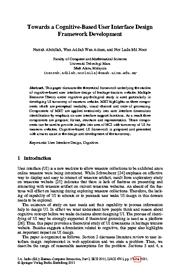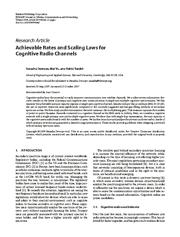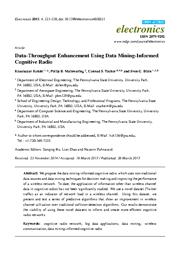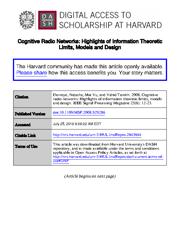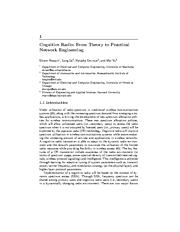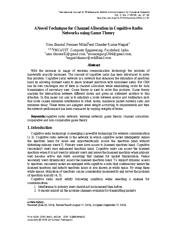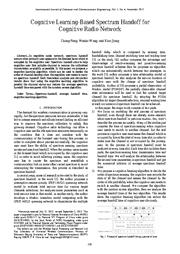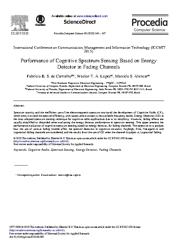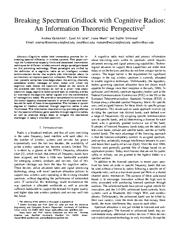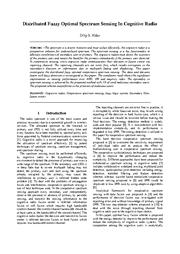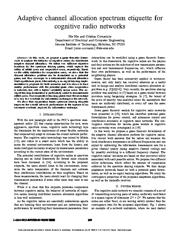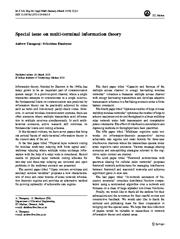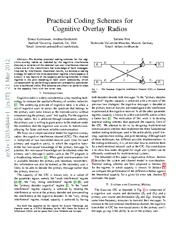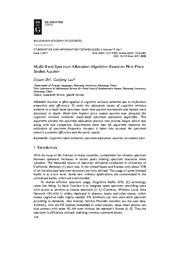A copy of this work was available on the public web and has been preserved in the Wayback Machine. The capture dates from 2020; you can also visit the original URL.
The file type is application/pdf.
Filters
Towards a Cognitive-Based User Interface Design Framework Development
[chapter]
2011
Lecture Notes in Computer Science
This paper discusses the theoretical framework underlying the studies of cognitive-based user interface design of heritage tourism website. ...
As a result three components are propose; format, structure and representation. These components can be used to provide insights into area of HCI with taxonomy of UI for museum websites. ...
Thus, this study plan to explore the theoretical foundation for supporting UI design particularly looking at UI in cognitive perspectives.
Why Cognitive Study? ...
doi:10.1007/978-3-642-21602-2_2
fatcat:ac62yp2qivdmhdaj7vwbs6y6ea
Achievable Rates and Scaling Laws for Cognitive Radio Channels
2008
EURASIP Journal on Wireless Communications and Networking
We outline recent information theoretic results on the limits of primary and cognitive user communication in single and multiple cognitive user scenarios. ...
We then study another information theoretic measure, the multiplexing gain. ...
This paper explores the limits of communication in cognitive channels from three distinct yet related information theoretic angles in its three main sections. ...
doi:10.1155/2008/896246
fatcat:tefkmjpjmja4dp3j2mb2hoiib4
Data-Throughput Enhancement Using Data Mining-Informed Cognitive Radio
2015
Electronics
Our results demonstrate the viability of using these novel datasets to inform and create more efficient cognitive radio networks. ...
To date, the application of information other than wireless channel data in cognitive radios has not been significantly studied. ...
Acknowledgments The authors thank Suppawong Tuarob for his contribution in providing the dataset of Tweets. Electronics 2015, 4 ...
doi:10.3390/electronics4020221
fatcat:3kpg6pplhjekpbv5xtf7zkpmx4
Cognitive radio networks
2008
IEEE Signal Processing Magazine
Cognitive radio networks: Highlights of information theoretic limits, models and design. IEEE Signal Processing Magazine 25(6): 12-23. ...
Published Version [ Highlights of information theoretic limits, models, and design ] ...
In the competitive channel, the two transmitters compete for the channel, forming a classic information theoretic interference channel. ...
doi:10.1109/msp.2008.929286
fatcat:avelzyfg45axrmoieethlg3y5q
Cognitive Radio: From Theory to Practical Network Engineering
[chapter]
2009
New Directions in Wireless Communications Research
We discuss some theoretical results on the effect of side information (e.g., spatial locations of the users, transmission probability of primary users) on the cognitive sensing performance. ...
For more precise information theoretic definitions we refer the reader to [18, 19, 114] . ...
We discuss some theoretical results on the effect of side information (e.g., spatial locations of the users, transmission probability of primary users) on the cognitive sensing performance. ...
doi:10.1007/978-1-4419-0673-1_10
fatcat:2n6y2hnicnhupkmo2hmqwfn3nq
A Novel Technique for Channel Allocation in Cognitive Radio Networks using Game Theory
2016
International Journal of Wireless and Mobile Communication for Industrial Systems
But CRN has its own challenges one of them is channel allocation while establishing route for data transmission of secondary user. Game theory is used to solve this problem. ...
Cognitive radio network is a network that enhances the utilization of spectrum band by allowing licensed users to share licensed spectrum with unlicensed users. ...
Cognitive users can access the licensed spectrum when it is not used by primary users and leaves the licensed spectrum when primary user become active and starts accessing that channel for packet transmission ...
doi:10.21742/ijwmcis.2016.3.2.07
fatcat:mug6y7ryqvdb3dlmkvrqtzbzbu
Cognitive Radio Networks: An Information Theoretic Perspective
[article]
2020
arXiv
pre-print
Information-theoretic limits of cognitive radio networks have been under exploration for more than a decade. ...
Outlining the state of the art in the information-theoretic analysis of different cognitive systems, we highlight the salient features/points of the capacity-achieving or capacity-approaching strategies ...
Open Fundamental Limits Here, we outline the open information-theoretic problems for the two-user, K-user, and MIMO cognitive interference channels. • Two-user cognitive interference channel: In the discrete ...
arXiv:2001.09261v1
fatcat:bfoyep6ja5gehgt5ndvndn4nxi
Cognitive Learning-Based Spectrum Handoff for Cognitive Radio Network
2012
International Journal of Computer and Communication Engineering
Both theoretical analysis and simulation results show that using the cognitive learning algorithm to predict the channel status can reduce the average spectrum handoff time compared with the random access ...
Spectrum handoff aims to help cognitive user find suitable channel to resume the unfinished transmission as quickly as possible. ...
During the cognitive learning process, the cognitive user records the information of the status before the current time slot i, then cognitive system will predict the primary channel status for time slot ...
doi:10.7763/ijcce.2012.v1.88
fatcat:wwk4dtgylfc6nl424e2a5rqnfy
Performance of Cognitive Spectrum Sensing Based on Energy Detector in Fading Channels
2015
Procedia Computer Science
This paper presents the performance evaluation of cognitive spectrum sensing, based on energy detector, for fading channels. ...
Rayleigh, Rice, Nakagami-m and Lognormal fading channels are considered, and the results favor the use of ED when the channel is subject to Lognormal fading. ...
Acknowledgements The authors would like to express their thanks to COPELE, Iecom, CEAR/UFPB, Capes and CNPq for the financial support of this work. ...
doi:10.1016/j.procs.2015.09.095
fatcat:k5tbeuioivfydo7yrhycrfw6du
Breaking Spectrum Gridlock With Cognitive Radios: An Information Theoretic Perspective
2009
Proceedings of the IEEE
This information theoretic survey provides guidelines for the spectral efficiency gains possible through cognitive radios, as well as practical design ideas to mitigate the coexistence challenges in today's ...
This side information typically comprises knowledge about the activity, channels, codebooks and/or messages of other nodes with which the cognitive node shares the spectrum. ...
Before launching into capacity results for these three cognitive radio networks, we will first review capacity results for the interference channel. ...
doi:10.1109/jproc.2009.2015717
fatcat:rvnkortxtneb7loisy6ceeriwy
Distributed Fuzzy Optimal Spectrum Sensing In Cognitive Radio
[article]
2013
arXiv
pre-print
The reporting channels are not error free, which results corruption in the secondary's decision or information due to multipath fading and shadowing. ...
The cognitive radios must detect the existence of the primary user and vacate the band for the primary immediately if the primary user detected. ...
As shown in Fig.3 the energy statistics of three secondary users are CR1=56.9, CR2=82.2, CR3=85.8 respectively, and the optimal decision is observed at 0.695, for Information Fusion strategy. ...
arXiv:1303.2169v1
fatcat:styp4bgnvvbdrob34h7iio5ytu
Adaptive Channel Allocation Spectrum Etiquette for Cognitive Radio Networks
2006
Journal on spesial topics in mobile networks and applications
In this work, we propose a game theoretic framework to analyze the behavior of cognitive radios for distributed adaptive channel allocation. ...
Based on the utility definition for cooperative users, we show that the channel allocation problem can be formulated as a potential game, and thus converges to a deterministic channel allocation Nash equilibrium ...
In this work, we propose a game theoretic formulation of the adaptive channel allocation problem for cognitive radios. ...
doi:10.1007/s11036-006-0049-y
fatcat:6cwiv2kla5hwpdbu5q2zp4gggq
Special issue on multi-terminal information theory
2013
International Journal of Advances in Engineering Sciences and Applied Mathematics
The fifth paper titled "Multiuser cognitive radio networks: An information-theoretic perspective" derives achievable rate regions and outer bounds for three-user interference channels where the transmitters ...
Recent results on physical layer network coding schemes for two-way and three-way relaying are reviewed and open problems in the multiway scenario are presented. ...
The fifth paper titled ''Multiuser cognitive radio networks: An information-theoretic perspective'' derives achievable rate regions and outer bounds for three-user interference channels where the transmitters ...
doi:10.1007/s12572-013-0085-3
fatcat:uxhdwmsjljh4pbmymajetfhyy4
Practical Coding Schemes for Cognitive Overlay Radios
[article]
2012
arXiv
pre-print
Inspired by information theoretical results, we develop a coding strategy for each of the three parameter regimes where capacity is known. ...
We develop practical coding schemes for the cognitive overlay radios as modeled by the cognitive interference channel, a variation of the classical two user interference channel where one of the transmitters ...
ACKNOWLEDGMENT The authors would like to thank Professor Gerhard Kramer for valuable discussions that helped to greatly improve the paper. ...
arXiv:1203.4844v2
fatcat:volpump5xfefvgisbdn3op7aby
Multi-Band Spectrum Allocation Algorithm Based on First-Price Sealed Auction
2017
Cybernetics and Information Technologies
Multi-item highest price sealed auction was designed for cognitive wireless networks'multi-band spectrum allocation algorithm. ...
Auction is often applied in cognitive wireless networks due to its fairness properties and efficiency. ...
Similarly, when the competition is very severe, 16 users all participate in bidding for the channels of SO1, and then the revenue is near the theoretical maximum. ...
doi:10.1515/cait-2017-0008
fatcat:w2ege2ihofgbhjrel5qoscspju
« Previous
Showing results 1 — 15 out of 70,521 results

